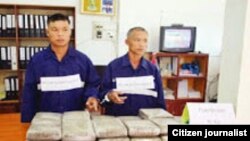MC: ລາຍງານສະຫະປະຊາຊາດສະບັບນຶ່ງ ກ່ຽວກັບການຄ້າຢາ
ເສບຕິດ ຢູ່ໃນທົ່ວໂລກ ກ່າວວ່າ ເອເຊຍ ໄດ້ປະເຊີນໜ້າເພີ້ມຂຶ້ນ
ກັບການໃຊ້ ແລະການລັກລອບການຄ້າຢາບ້າປະເພດກະຕຸ້ນ
ປະສາດ ຫລື ATS ຍ້ອນສາມາດຊອກຫາ ໄດ້ງ່າຍຂຶ້ນ ສານເຄ
ມີຕົ້ນທີ່ສຳຄັນ ຈາກປະເທດຕ່າງໆຢູ່ໃນຂົງເຂດ. ດັ່ງທີ່ນັກຂ່າວ
ວີໂອເອ Ron Corben ລາຍງຈາກບາງກອກ ກໍແມ່ນວ່າຂົງເຂດ
ເອເຊຍຍັງປະເຊີນໜ້າກັບການທ້າທາຍ ຈາກການຄ້າຢາເສບຕິດ
ທີ່ຜິດກົດໝາຍ ທາງອິນເຕີແນັດນຳດ້ວຍ. ກິ່ງສະຫວັນ ມີລາຍລະ
ອຽດກ່ຽວກັບເລື່ອງນີ້ ມາສະເໜີທ່ານ.
ລາຍງານຂອງອົງການຄວບຄຸມຢາເສບຕິດແລະຕໍ່ຕ້ານອາດຊະຍາກຳຂອງ ສະຫະປະຊາ
ຊາດ ຫລື UNODC ກ່າວວ່າ ຂົງເຂດເອເຊຍພົບເຫັນວ່າ ມີການເພີ້ມຂຶ້ນຢ່າງວ່ອງໄວໃນ
ການຜະລິດຢາບ້າ ປະເພດກະຕຸ້ນປະສາດ ATS ໃນລະ ຍະບໍ່ເທົ່າໃດປີທີ່ຜ່ານມານີ້ຢູ່ໃນ
ຂົງເຂດ ຊຶ່ງປະກອບເປັນຫຼາຍເຖິງ 50 ເປີເຊັນ ຂອງບັນດາຜູ້ຊົມໃຊ້ຢາເສບຕິດດັ່ງກ່າວຢູ່
ໃນໂລກ.
ຜູ້ປະສານງານໂຄງການຂອງ UNODC ໃນເຂດເອເຊຍຕາເວັນອອກ ທ່ານ Tun Nay
Soe ກ່າວວ່າ ການໃຊ້ຢາບ້າ ເປັນບັນຫາທ້າທາຍທີ່ສຳຄັນຕໍ່ຂົງເຂດ.
ທ່ານ Tun Nay Soe ກ່າວວ່າ “ຢາບ້າ ຫລື Methamphetamine ນີ້ແມ່ນບັນຫາໃຫຍ່
ທີ່ສຸດ. ນັບແຕ່ປີ 2008 ເປັນຕົ້ນມາ ມັນໄດ້ສະແດງໃຫ້ເຫັນເຖິງການເຕີບໂຕຢ່າງວ່ອງໄວ.
ໃນປີ 2008 ມັນມີພຽງແຕ່ 32 ຫລື 33 ລ້ານເມັດ ເທົ່ານັ້ນ ແຕ່ໃນປີ 2012 ພວກເຮົາມີ
ເກືອບ
230 ລ້ານເມັດ. ແລະເຖິງຢ່າງນັ້ນ ກໍຕາມ ຂໍ້ມູນຍັງບໍ່ທັນຄົບຖ້ວນເທື່ອ ແຕ່ດ້ວຍຂໍ້ມູນທີ່
ພວກເຮົາມີຢູ່ໃນປັດຈຸບັນນີ້ ພວກເຮົາສາມາດປະເມີນໄດ້ວ່າ ມັນຈະບໍ່ຫລຸດລະດັບຂອງປີ 2012.”
ທ່າອຽງທີ່ຄ້າຍຄືກັນນີ້ ກໍເປັນຫລັກຖານຢືນຢັນກັບພວກໃຊ້ຢາບ້າ ຊະນິດໃສໆ ທີ່ຮູ້ກັນໃນ
ອີກຊື່ນຶ່ງວ່າ “ice” ນັ້ນ ໄດ້ສູງຂື້ນຢ່າງວ່ອງໄວຈາກສິບປີກ່ອນຢູ່ໃນ ປະເທດລາວ ກຳປູເຈຍ ໄທ ແລະຫວຽດນາມ. ການຍຶດຢາບ້າປະເພດ “ice” ຢູ່ໃນຂົງເຂດໃນແຕ່ລະປີ ແມ່ນ 1 ລ້ານ
6 ແສນໂຕນ.
ສານເຄມີທີ່ສຳຄັນສຳລັບໃຊ້ຜະລິດປະເພດກະຕຸ້ນປະສາດ ແມ່ນມາຈາກຫລາຍປະເທດຢູ່ໃນຂົງເຂດ ທີ່ນຳໜ້າໂດຍ ເກົາຫລີ ຍີ່ປຸ່ນ ສິງກະໂປ ໄທ ຈີນ ແລະອິນເດຍ ບ່ອນທີ່ສານເຄ
ມີເຫຼົ່ານີ້ ໄດ້ຖືກຫັນປ່ຽນຈາກການໃຊ້ຢ່າງຖືກຕ້ອງຕາມກົດໝາຍ ມາເປັນການຄ້າທີ່ຜິດກົດໝາຍ.
ອົງການ UNODC ກ່າວວ່າ ປະມານ 243 ລ້ານຄົນ ທີ່ມີອາຍຸ ລະຫວ່າງ 15 ຫາ 64 ປີ ຄື
ປະມານ ຫ້າເປີເຊັນຂອງພົນລະເມືອງໂລກ ກ່າວກັນວ່າ ໄດ້ໃຊ້ຢາເສບຕິດທີ່ຜິດກົດໝາຍ ໃນຮອບປີທີ່ຜ່ານມາ. ໃນແຕ່ລະປີມີປະມານ 200,000 ຄົນເສຍຊີວິດເນື່ອງມາຈາກການ
ໃຊ້ຢາເສບຕິດທີ່ຜິດກົດໝາຍ ໂດຍທີ່ທາງຄອບ ຄົວຖືກປະປ່ອຍໃຫ້ໄດ້ຮັບຄວາມຍາກ
ລຳບາກ.
ການຜະລິດຢາຝິ່ນ ຊຶ່ງເປັນວັດຖຸດິບສຳລັບເຮໂຮອິນນັ້ນ ແມ່ນນຳໜ້າໂດຍ ອັຟການິສຖານ
ທີ່ໄດ້ມີການເພີ້ມເນື້ອທີ່ໃນການປູກຝັງຂື້ນເຖິງ 36 ເປີເຊັນ ໃນປີ 2013 ເປັນ 154,000 ເຮັກ
ຕາ ໂດຍສາມາດຜະລິດຝິ່ນໄດ້ 5,500 ໂຕນ ຊຶ່ງ ປະກອບເປັນ 80 ເປີເຊັນຂອງການຜະລິດ
ຝິ່ນຢູ່ໃນໂລກ.
ຢູ່ໃນມຽນມາ ຊຶ່ງເປັນປະເທດທີ່ຜະລິດຝິ່ນ ຫຼາຍເປັນອັນດັບສອງຂອງໂລກນັ້ນ ເນື້ອທີ່ການປູກຝັງແມ່ນຍັງຢູ່ໃນລະດັບປະມານ 57,800 ເຮັກຕາຊຶ່ງສ່ວນໃຫຍ່ແລ້ວຢູ່ໃນລັດສານ ທາງ
ພາກເໜືອຂອງປະເທດ.
ທ່ານ Tun Nay Soe ຈາກ ຈາກອົງການ UNODC ກ່າວວ່າ ຄວາມທຸກຍາກເປັນແຮງກົດ
ດັນຢູ່ເບື້ອງຫລັງພາໃຫ້ພວກຊາວບ້ານໃນລັດສານຫັນໄປຜະລິດຢາຝິ່ນ.
ທ່ານ Tun Nay Soe ກ່າວວ່າ “ໝູ່ບ້ານທີ່ປູກຢາຝິ່ນສ່ວນຫລາຍ ແມ່ນຢູ່ໃນເຂດສອກຫລີກ
ເພາະສະນັ້ນສິ່ງທີ່ເກີດຂື້ນກໍຄື ສຳລັບພວກເຂົາເຈົ້າຈະປູກພືດ ຜັກແລະນຳໄປຂາຍນັ້ນ ແມ່ນ
ມີຄວາມຍາກລຳ ບາກ ເພາະວ່າ ລະບົບການຂົນສົ່ງບໍ່ສະດວກ. ແຕ່ການປູກຢາຝິ່ນນັ້ນມີຄວາມແຕກຕ່າງກັນຫຼາຍ. ເຂົາເຈົ້າບໍ່ມີຄວາມຈຳເປັນຕ້ອງໄດ້ນຳອອກໄປຂາຍ ພວກຄ້າຢາເສບຕິດພຽງແຕ່ມາເຄາະປະຕູຂອງເຂົາເຈົ້າເທົ່ານັ້ນ. ຕາບໃດທີ່ເຮົາຍັງບໍ່ມີຄວາມສາມາດ
ແກ້ໄຂບັນຫາຄວາມທຸກຍາກຢູ່ໃນລັດສານໄດ້ຂ້າພະເຈົ້າບໍ່ຄິດເລີຍວ່າພວກເຮົາຈະສາມາດ
ຍຸດຕິການ ປູກຝິ່ນຢູ່ໃນມຽນມາໄດ້.”
ອົງການ UNODC ກ່າວວ່າ ເຮໂຣອິນ ຍັງສືບຕໍ່ເປັນບັນຫາທີ່ສ້າງຄວາມວິຕົກ ກັງວົນທີ່
ສຳຄັນອັນນຶ່ງ ຢູ່ໃນຫລາຍໆປະເທດໃນເຂດເອເຊຍ ຮວມທັງ ຈີນ ມາເລເຊຍ ມຽນມາ
ແລະຫວຽດນາມ.
ທ່ານ Tun Nay Soe ກ່າວວ່າ ການຂົ່ມຂູ່ອີກຢ່າງອື່ນນັ້ນກໍຄື ຜ່ານການຜະລິດ ແລະການ
ລັກລອບຄ້າຢາເສບຕິດ ທີ່ເຮັດຈາກສານເຄມີຊະນິດໃໝ່ ເພື່ອກະຕຸ້ນລະບົບສູນກາງເສັ້ນ
ປະສາດຫຼື psycho-active ແລະການຄ້າທາງອິນເຕີແນັດ. ຢາເສບຕິດເຫລົ່ານີ້ ມັກຈະຢູ່
ນອກກົດໝາຍທີ່ມີຢູ່ແລ້ວ ແລະຮູ້ກັນພຽງເລັກນ້ອຍເຖິງຜົນກະທົບຕໍ່ປະຊາຄົມ.
ທາດແທ້ຂອງການຄ້າຢາເສບຕິດທີ່ຜິດກົດໝາຍຜ່ານທາງອິນເຕີແນັດ ເຮັດໃຫ້ ເປັນການ
ຍາກທີ່ບັນດາເຈົ້າໜ້າທີ່ ຈະລະບຸພວກທີ່ເປັນເຈົ້າຂອງເວັບໄຊທ໌ ແລະບັນດາຜູ້ຊົມໃຊ້ ແລະ
ເປັນທີ່ຮູ້ກັນໃນນາມ “ຕາໜ່າງມືດ” ໂດຍທີ່ບັນດາເຈົ້າໜ້າທີ່ກ່າວວ່າ ອາດມີມູນຄ່າເຖິງ
ຫລາຍພັນລ້ານໂດລາ.
ບັນດາເຈົ້າໜ້າທີ່ສະຫະປະຊາຊາດ ກ່າວວ່າ ການລັກລອບຄ້າຢາເສບຕິດທີ່ຜິດກົດໝາຍ
ນັ້ນ ຍັງສືບຕໍ່ຂະຫຍາຍຕົວ ຊຶ່ງມັກຈະເກີດຈາກບັນຫາ ຄວາມບໍ່ສອດຄ່ອງກັນແລະການສໍ້
ລາດບັງຫລວງຂອງຜູ້ປະຕິບັດກົດໝາຍ ແລະ ບັນຫາດ້ານຍຸຕິທຳ ແລະສຸຂະພາບ.
The United Nations Office on Drugs and Crime (UNODC) released the 2014 World Drug Report on global drug trafficking Thursday to mark International Day against Drug Abuse and Illicit Trafficking.
Asia has faced increases in use and trafficking of amphetamine-type stimulants (ATS), the report says, aided by easy access to key precursor chemicals from regional economies. UNODC researchers also say the region is facing challenges from Internet trading in illegal drugs.
According to researchers, Asia has also witnessed a rapid rise in amphetamine-type stimulant production in recent years, and the region now accounts for up to 50 percent of the drug's global users.
Tun Nay Soe, UNODC program coordinator for East Asia, says methamphetamine use poses a major challenge to the region.
"Methamphetamine — this is the biggest issue," he said. "From 2008 it was showing the dramatic increase. In 2008 it was just only 32 or 33 million [pills], but in 2012 we have like over nearly 230 million. And even though the data is not completed yet ... we can project it is not going to be less than 2012."
A similar trend is evident with users of crystalline amphetamine, also known as "ice," which is up sharply from a decade ago in Laos, Cambodia, Thailand and Vietnam. Annual crystalline methamphetamine seizures in the region are at 11.6 metric tons.
Chemicals that are key to producing ATS-type drugs come from several regional countries, led by Korea, Japan, Singapore, Thailand, China and India, where chemicals are diverted from legal to illegal trade.
The UNODC says around 243 million people aged between 15 and 64 — about five percent of the world's population — are said to have used illicit drugs in the past year. Each year about 200,000 people die of illicit drug use, with families left to bear the hardship.
Production of opium, the raw material for heroin, is led by Afghanistan, which in 2013 was saw a 36 percent increase in cultivation area to 154,000 hectares. The country currently produces an estimated 5,500 tons of opium, accounting for 80 percent of global production.
In Myanmar, also known as Burma, the world's second largest opium producer, the area under cultivation stands at around 57,800 hectares — largely concentrated in northern Shan state.
The UNODC's Tun Nay Soe says poverty is the driving force behind the Shan villagers' production.
"Most of these opium growing villages are in remote areas," he said. "For them to grow cash crops and sell [them] is really difficult because transportation infrastructure is not really good. But growing opium is totally different. They do not need to go out and sell this. The traffickers just knock on their door. As long as we are not able to address the poverty issues in Shan state I don't really think we will be able to end this opium cultivation in Myanmar."
The UNODC says heroin remains a major concern across several Asian countries including China, Malaysia, Myanmar and Vietnam.
The other threat, says Tun Nay Soe, is through production and trafficking of new psycho-active substances and Web-based trading. The drugs are often categorized outside existing laws and little is known about the extent of their impact on the community.
The virtual trading in illicit drugs on the Internet
makes it difficult for authorities to identify website owners and users who are a part of the so-called "dark net," which authorities say may be worth billions of dollars.
U.N. officials say illegal trafficking in drugs is continuing to expand, often undermined by issues of inconsistent and corrupt law enforcement, and issues of justice and health.











